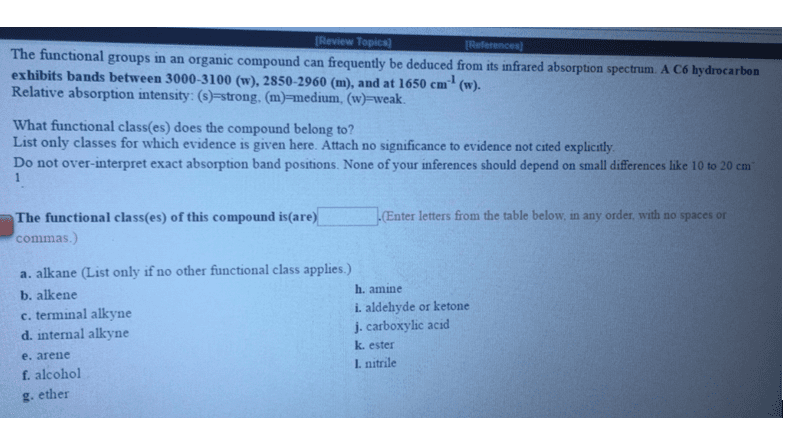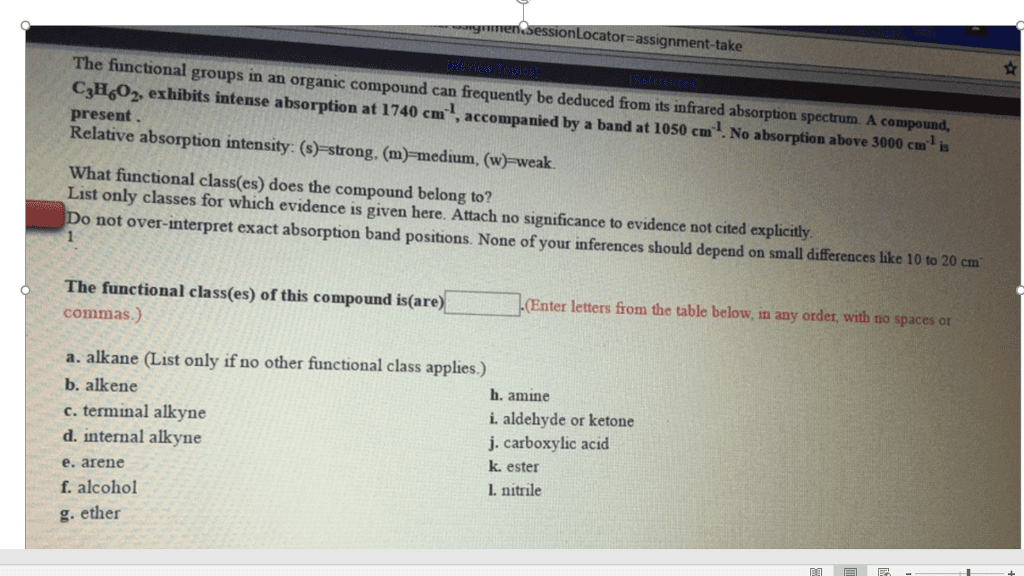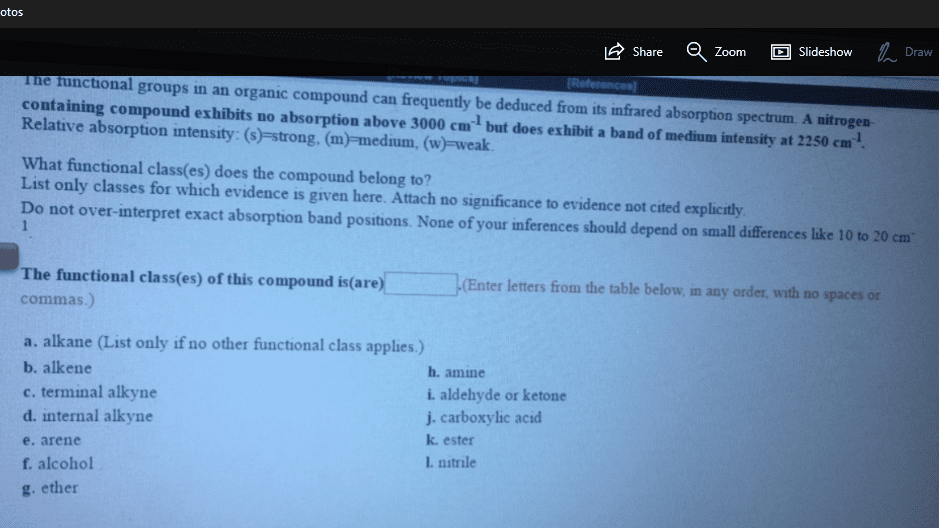1) The functional groups in an organic compound can frequently be deduced from its infrared absorption spectrum. A hydrocarbon exhibits no bands above 3000 but gives weak absorption at 2200 cm-1.
Relative absorption intensity: (s)=strong, (m)=medium, (w)=weak.
What functional class(es) does the compound belong to?
List only classes for which evidence is given here. Attach no significance to evidence not cited explicitly.
Do not over-interpret exact absorption band positions. None of your inferences should depend on small differences like 10 to 20 cm-1.
The functional class(es) of this compound is(are).(Enter letters from the table below, in any order, with no spaces or commas.)
a. alkane (List only if no other functional class applies.) b. alkene h. amine c. terminal alkyne i. aldehyde or ketone d. internal alkyne j. carboxylic acid e. arene k. ester f. alcohol l. nitrile g. ether
2) The functional groups in an organic compound can frequently be deduced from its infrared absorption spectrum. A compound containing C, H, and O exhibits strong, broad absorption band at 3430 cm-1, a sharp band at 3300, and a band at 2200 cm-1 (m).
Relative absorption intensity: (s)=strong, (m)=medium, (w)=weak.
What functional class(es) does the compound belong to?
List only classes for which evidence is given here. Attach no significance to evidence not cited explicitly.
Do not over-interpret exact absorption band positions. None of your inferences should depend on small differences like 10 to 20 cm-1.
The functional class(es) of this compound is(are).(Enter letters from the table below, in any order, with no spaces or commas.)
a. alkane (List only if no other functional class applies.) b. alkene h. amine c. terminal alkyne i. aldehyde or ketone d. internal alkyne j. carboxylic acid e. arene k. ester f. alcohol l. nitrile g. ether
3) The functional groups in an organic compound can frequently be deduced from its infrared absorption spectrum. A C6 hydrocarbon exhibits bands between 3000-3100 (w), 2850-2960 (m), and at 1650 cm-1 (w).
Relative absorption intensity: (s)=strong, (m)=medium, (w)=weak.
What functional class(es) does the compound belong to?
List only classes for which evidence is given here. Attach no significance to evidence not cited explicitly.
Do not over-interpret exact absorption band positions. None of your inferences should depend on small differences like 10 to 20 cm-1.
The functional class(es) of this compound is(are).(Enter letters from the table below, in any order, with no spaces or commas.)
a. alkane (List only if no other functional class applies.) b. alkene h. amine c. terminal alkyne i. aldehyde or ketone d. internal alkyne j. carboxylic acid e. arene k. ester f. alcohol l. nitrile g. ether
1) The functional groups in an organic compound can frequently be deduced from its infrared absorption spectrum. A hydrocarbon exhibits no bands above 3000 but gives weak absorption at 2200 cm-1.
Relative absorption intensity: (s)=strong, (m)=medium, (w)=weak.
What functional class(es) does the compound belong to?
List only classes for which evidence is given here. Attach no significance to evidence not cited explicitly.
Do not over-interpret exact absorption band positions. None of your inferences should depend on small differences like 10 to 20 cm-1.
The functional class(es) of this compound is(are).(Enter letters from the table below, in any order, with no spaces or commas.)
| a. alkane (List only if no other functional class applies.) | ||||||||||||||||||||||||||
| b. alkene | h. amine | |||||||||||||||||||||||||
| c. terminal alkyne | i. aldehyde or ketone | |||||||||||||||||||||||||
| d. internal alkyne | j. carboxylic acid | |||||||||||||||||||||||||
| e. arene | k. ester | |||||||||||||||||||||||||
| f. alcohol | l. nitrile | |||||||||||||||||||||||||
| g. ether 2) The functional groups in an organic compound can frequently be deduced from its infrared absorption spectrum. A compound containing C, H, and O exhibits strong, broad absorption band at 3430 cm-1, a sharp band at 3300, and a band at 2200 cm-1 (m).
|






